

|
Ohm on the Range: RV Electricity |
Tuesday, 15 Oct 2002 written by Sterling |
| An RV is, in a way, half house and half car. In fact, some states actually refer to RVs as "house cars" in their law. And there are few aspects of RVing that show this hybridization more than electricity. We have both household and automotive electrical systems on board, and this is one of the things that makes RV power so, ummm, interesting - the continual interaction between the two. |
Tech Notes California is one such state. |
| The standard for household electricity in the USA is 110 volts, alternating current (110VAC). I know, there are some things that use 220VAC, but we can safely ignore those for the moment. Since an RV is meant for living in, and thus using some household appliances in, it will typically have a 110VAC system. In our case, it runs the microwave oven, it would run the air conditioner if we had one, and it can run the refrigerator. We also have ordinary household-style outlets scattered around the interior (and one on the exterior) for plugging in anything else we might want to run. At the top of this list are the satellite modems that enable our Internet connection; because our service is DirecWay, a system with its roots in the home market, it runs from 110VAC. Our computers also need 110VAC when their internal batteries run low. | Our fridge is what's known as 3-way: it can run from 110VAC, 12VDC, or propane. However, when cooling from 12V it pulls almost 18 amps, and since our charging circuit from the truck alternator only produces about 12 amps, this means that we can't use the fridge on DC even when the truck is running without draining our battery! So we run it on AC when we're on shore power and propane the rest of the time. |
| 12 volts of direct current is the automotive standard, and an RV has a full 12VDC system as well. This runs lights, fans (including the furnace blower), the water pump, the fridge (optionally), and a few other items. One notable "other item" in our case is the satellite dish positioner, the device that (usually) finds the satellite and points the dish at it when we get to a new location - also crucial for our 'net connection. | The dish positioner uses very little power, about 400mA at 12V. They claim it can run off a 9V battery, but they don't tell you how, so I suspect this is mostly advertising hyperbole. |
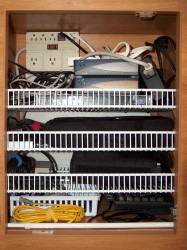 There are also means to convert between 110VAC and 12VDC, in both directions. From 110VAC to 12VDC is called a converter, and in the other direction it's an inverter. Yeah, the names are confusing, and don't ask me to explain why they are how they are, because I can't. But suffice it to say we have one of each, so we can change one form of electricity into the other when we want to. It's not always in sufficient quantity to run everything we might want to, but it's usually enough.
There are also means to convert between 110VAC and 12VDC, in both directions. From 110VAC to 12VDC is called a converter, and in the other direction it's an inverter. Yeah, the names are confusing, and don't ask me to explain why they are how they are, because I can't. But suffice it to say we have one of each, so we can change one form of electricity into the other when we want to. It's not always in sufficient quantity to run everything we might want to, but it's usually enough.
|
Our inverter right now is a StatPower ProWATT 250. It so rarely runs anything except the computers and satellite modems that I wired a cigarette lighter outlet into the "server room" just for it. |
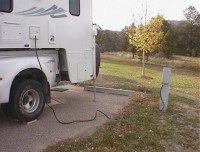 Why would we want to? Well, that actually brings us to the other interesting part of electricity in an RV: ensuring an adequate supply. You don't think much about this in a bricks 'n' sticks home, because your house is "plugged in to the mains", as my wife's people call it. As long as you pay your bill, you have essentially as much electricity as you need. We can plug our camper in as well, more literally than you do your house - we actually have a plug, and we carry an extension cord with us. This is useful when we're in a campground with electrical hookups, or occasionally when we're visiting someone who'll let us plug in. This lets us run the 110VAC stuff mentioned above, as well as the 12VDC stuff via the converter. Essentially, we can run anything electric when we're plugged in.
Why would we want to? Well, that actually brings us to the other interesting part of electricity in an RV: ensuring an adequate supply. You don't think much about this in a bricks 'n' sticks home, because your house is "plugged in to the mains", as my wife's people call it. As long as you pay your bill, you have essentially as much electricity as you need. We can plug our camper in as well, more literally than you do your house - we actually have a plug, and we carry an extension cord with us. This is useful when we're in a campground with electrical hookups, or occasionally when we're visiting someone who'll let us plug in. This lets us run the 110VAC stuff mentioned above, as well as the 12VDC stuff via the converter. Essentially, we can run anything electric when we're plugged in.
|
Our shore power service is 30A, meaning we need an adapter (which we also carry) to plug into an ordinary 15A household outlet. We use way less than 15A because we're not running an air conditioner, but most campground hookups are at least 30A anyway. |
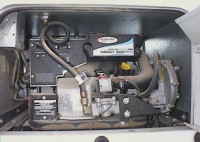 But of course, our house rides around on a truck, and thus can't always be plugged in (our extension cord isn't that long). The first solution to this problem is in the form of a generator, which we carry with us. It runs on propane (because that's the only fuel the camper has on board), and makes 110VAC from it. When the generator is running, it's as if we were plugged into the grid - we can run anything electrical that we have. But the generator is noisy, makes smelly exhaust, and has high upkeep costs. We don't really want to run it all the time, but it's nice to have when we need it.
But of course, our house rides around on a truck, and thus can't always be plugged in (our extension cord isn't that long). The first solution to this problem is in the form of a generator, which we carry with us. It runs on propane (because that's the only fuel the camper has on board), and makes 110VAC from it. When the generator is running, it's as if we were plugged into the grid - we can run anything electrical that we have. But the generator is noisy, makes smelly exhaust, and has high upkeep costs. We don't really want to run it all the time, but it's nice to have when we need it.
|
We have about 50' of cord for the camper.
Our genset is a Generac Impact 36LP, 3.4kW. It's notable for producing DC natively (at 375V, they tell me) and then having its own inverter to make AC. They claim this makes it more efficient. |
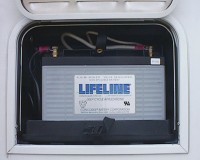 No, the primary answer to portable electricity is battery power. The battery basically stores 12VDC electricity, and we can use it when we want to. This lets us run most of the things we need to - lights, water pump, dish positioner, and through the inverter, computers and satellite modems. Our present inverter's not big enough to run the microwave, but we can live with that, or just turn the generator on for 3 minutes when it's popcorn time. The catch is that the battery just stores electricity, it doesn't create it like the generator does. So we can only run from the battery for a limited time before we have to recharge it. Because our power needs are fairly high, and our camper doesn't have room for much battery, we can only last about a day. So the next issue is, how to charge it?
No, the primary answer to portable electricity is battery power. The battery basically stores 12VDC electricity, and we can use it when we want to. This lets us run most of the things we need to - lights, water pump, dish positioner, and through the inverter, computers and satellite modems. Our present inverter's not big enough to run the microwave, but we can live with that, or just turn the generator on for 3 minutes when it's popcorn time. The catch is that the battery just stores electricity, it doesn't create it like the generator does. So we can only run from the battery for a limited time before we have to recharge it. Because our power needs are fairly high, and our camper doesn't have room for much battery, we can only last about a day. So the next issue is, how to charge it? |
We have a Lifeline Group 31 AGM battery, rated at 105Ah. Since we only have the one (fairly small) battery, I felt it worthwhile to split with the $$$ for an AGM due to its faster charge rate and better safety. |
| First, it will charge from the truck's electrical system (which is the standard automotive 12VDC, remember) whenever the truck's engine is running. So on travel days we'll get a good few hours of charge, and on those days we're also not using as much electricity, because our satellite connection only works when we're stationary. But it's worth mentioning. | Our Ford diesel has a space for a second alternator, but that doesn't seem to be our limiting factor in charging the camper battery, so I've not pursued it yet. Maybe on the F-550… |
| Second, our 110VAC-12VDC converter also charges our battery whenever we're on "shore power" (you can tell RVers borrow technology from boaters), or when the generator's running. It charges a lot faster than many older RV battery chargers did, meaning that when we need a charge in the middle of nowhere, we can get good effect from just running our generator for an hour or so. But this isn't a real solution - our whole aim here is to be mobile (i.e., off the grid) without running the generator. | Our converter is a Progressive Dynamics Intelli-Power 9145 with the "Charge Wizard" add-on, making it into a true 3-stage charger capable of using the charger's full 45 amps during the bulk phase. |
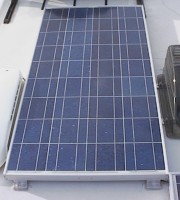 So our third charging option is solar. We've installed a couple of big panels on the roof of our camper, and whenever the sun is shining they charge our battery. These are quite new, only installed 4 days before I wrote this, so it's not yet clear whether they'll make the difference we hope they will. It's also hard to tell right now, because we're in a somewhat northern latitude, and the sun's pretty low in the sky this time of year, both of which decrease the amount of sunlight on the panels. I'll report back when we know more.
So our third charging option is solar. We've installed a couple of big panels on the roof of our camper, and whenever the sun is shining they charge our battery. These are quite new, only installed 4 days before I wrote this, so it's not yet clear whether they'll make the difference we hope they will. It's also hard to tell right now, because we're in a somewhat northern latitude, and the sun's pretty low in the sky this time of year, both of which decrease the amount of sunlight on the panels. I'll report back when we know more.
|
They're Kyocera 120W modules flat-mounted to the roof, purchased from ETA Engineering out of Tempe, Arizona.
The camper came "pre-wired for solar", meaning it had 12-gauge wires from the roof to the battery area. 12 was just big enough for our needs. |
| Sound complicated? It is! If you're an RVer that usually stays in campgrounds with electrical hookups, you probably never have to worry about it. But our experience has been that a lot of the best places don't have hookups at all, so we worry about it a lot. It's also ironic that our quest for an RV that would take us to out-of-the-way places resulted in a rig that is actually less self-sufficient when we get there. A big fifth-wheel trailer or Class A motorhome would have room for lots more batteries & solar panels than we can carry. But then, it wouldn't be able to go to some of the places we can. Lemme tell you about this dirt road we found ourselves on yesterday… The best solution would be a real expedition vehicle, but that's another tale. |
Case in point: Guernsey State Park in Wyoming. |
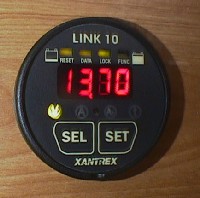 One other thing we've just added that we're hoping will make a big difference is an amp-hour meter. Basically, the problem is that it's very difficult to tell on an ongoing basis how much power your battery actually has left in it, especially with multiple charging sources and widely varying power usage. A good amp-hour meter solves this problem by virtually monitoring every electron going in or out of the battery, then telling you how many you have left at any given time. I just installed ours today (my inspiration to write this article now), but we have high hopes that it'll help a lot as we try to manage our electrical consumption and production.
One other thing we've just added that we're hoping will make a big difference is an amp-hour meter. Basically, the problem is that it's very difficult to tell on an ongoing basis how much power your battery actually has left in it, especially with multiple charging sources and widely varying power usage. A good amp-hour meter solves this problem by virtually monitoring every electron going in or out of the battery, then telling you how many you have left at any given time. I just installed ours today (my inspiration to write this article now), but we have high hopes that it'll help a lot as we try to manage our electrical consumption and production.
|
As you can see, it's a Xantrex Link-10, with lots of additional functionality besides simple amp-hour measurement. It even let us input our own Peukert exponent, in our case 1.164 for the Lifeline 31. |
| What electrical improvements does the future hold for us? It's hard to say. We may or may not have room for a third panel on the roof if we need it. We'd like to add a nice big inverter that would let us run the microwave for short times from the battery, and make better use of our solar panels even when we're on shore power. And if we upgrade our truck as we'd like to, we'd have the carrying capacity to add a couple of much larger batteries to our system. As always, stay tuned! |
We're running a SunAmp 22A PV charge controller, which has the capacity for a third panel if needed.
I have my eye on a ProSine 1.8kW pure-sine-wave inverter, but we're not sure we have the room (in the camper or the budget) for it. |
In closing, I wanted to detail one absurd but not uncommon situation with our electrical system. It goes something like this: The generator converts propane into 375VDC, its built-in inverter changes that into 110VAC, our camper's power converter makes that into 12VDC, our little standalone inverter converts that back into 110VAC, and finally the laptop computer's power supply converts that into 19VDC. Whew!
Update |
Sunday, 26 September 2004 |
Over the couple of years following this article, I did substantial upgrades to the electrical system - and (of course) I wrote an article about them, too.
Do you know someone who would enjoy this article? Click to e-mail it to them!
| Home | Log | Notes | Maps | Contact | Store |
| Home | Log | Notes | Maps | Contact |